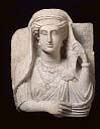| |
When Tudmor
was fully occupied by the Romans under Tiberius, Augustus' successor
and was integrated into the Province of Syria between 14-37 AD, Tudmor
became known as the city of palm trees, and flourished even
more: it imposed high taxes on goods from the caravans, and its
horsemen fought alongside the Roman armies.
When the Roman emperor Adrian visited Palmyra, he declared her a ?free
city?; in return, the people of Tudmor gratefully called their city
?Adriana Palmyra?. When the Severus emperors, who were originally
Syrian (Homs),
came to rule Palmyra, they treated her people extremely well. The
Emperor Caracalla declared her a Roman colony (212 AD), something the
Palmyrians had always hoped for, since it exempted them from paying
taxes on luxury items such as perfumes, spices, ivory, glass and silk.
This made the city a luxurious one: new constructions, street, arches,
temples and statues were built, making Palmyra one of the greatest
cities of the Roman empire.
When the conflict between Persia and Rome reached its crisis, Rome
resorted to the ruler of Palmyra for help.
The leader Septimus Odeinat (Odenathus) became quite favoured by Rome
and in 256/7 was appointed by the Emperor Valerian as Consul and
Governor of the province of Syria Phoenice which Palmyra had been
transferred to in 194. A few years later Valerian was captured and
murdered by the Sassanian Persians, and in redemption Odeinat
campaigned as far as the Sassanian capital Ctesiphon.
Palmyra's greatest days however were after the murder of Odeinat, when
his wife Zenobia started ruling Palmyra on behalf of her son
Vaballath. Zenobia, women renowned for her exceptionally
strong character, took power. She ruled Palmyra in a way that
astonished both West and East. She was exceptionally intelligent and
attractive. She was a gifted linguist, an eloquent speaker of
Palmyrian, Greek and Egyptian.
Zenobia had a wide knowledge of politics, and in her court, she
had many philosophers, scholars and theologians. Queen Zenobia was
soon fired by the ambition of getting rid of Roman domination. In 268,
during the reign of Emperor Aurelian, Zenobia with the help of her
Prime Minister Longinus, she decided to conquer all of Rome?s
territories. Aurelian was then very much engaged in internal conflicts
as well as external wars. This enabled Queen Zenobia to take over the
whole of Syria, she headed for the north and attempted to take
Antioch, conquer Egypt (269-270) and send her armies to Asia Minor,
gaining control thereby of all the land and sea-ways to the Far East.
She took the title of ?August?, which was only used by the emperor of
Rome, and she had money coined with her and her son?s likeness upon
it, without that of the emperor of Rome. However, the Emperor Aurelian
took quick action in setting his internal disputes, and started to
plan his revenge on Queen Zenobia. He formed a new army for this
purpose, which proceeded through Turkey to conquer Zenobia?s army in
its first defensive position in
Homs (Emesa).
It besieged Palmyra until it fell in 274. Queen Zenobia was defeated
and taken captive to Rome, fettered in chain gold.
The destiny of the great kingdom of Palmyra was no better than that of
its queen; the city fell prey to looting and destruction.
Archaeologists are still working on excavations there in order to
uncover the queen?s palace, which was destroyed by the Romans and
replaced by a military camp. Queen Zenobia?s ambitious dream is still
embodied in the magnificent remains of what she built.
Later in the Byzantine period a few churches were built and added to
the much ruined city. It was then taken by the Arabs under Khaled Ibn
Al Walid who was leader of the Arab army under the Caliph Abu Bakr. It
played a minor defensive role during the Islamic periods although the
Umayyads built the two Qasr Al Heirs. Later Temple of Baal
was fortified and the Arab Castle of Fakhredin Al Maany was
built. Since then it has had no major roles and the ruins have fallen
victim to natural erosion.
|
|

Ruins Stand

Sepulchral Relief

Triumphal Arch and Colonnade |




